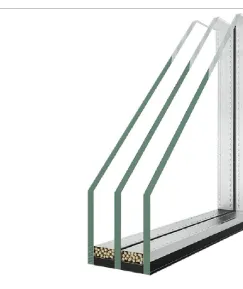

In the ever - evolving world of construction and building design, energy efficiency has become a top priority. Low e glass stands at the forefront of this movement, offering a range of solutions that not only enhance a building's thermal performance but also contribute to cost savings and environmental sustainability. From low e glass panels and low e glass panes to the impact - resistant low e impact glass, the privacy - providing low e obscure glass, and the advanced low e plus glass, each variant caters to specific needs, revolutionizing the way we think about windows and glass facades.

Low e glass panels are a popular choice for a wide variety of applications, thanks to their versatility and energy - saving capabilities. These panels are designed to reduce the transfer of heat through windows and glass walls, keeping interiors cooler in the summer and warmer in the winter. In commercial buildings, low e glass panels can be used in large - scale curtain walls, allowing natural light to flood the interior while minimizing the need for excessive heating and cooling. For instance, in an office building, these panels can create a comfortable working environment, improving employee productivity. In residential settings, low e glass panels in windows can significantly reduce energy bills, as they prevent heat from escaping during cold months and block unwanted solar heat gain during hot seasons. The panels come in different sizes and thicknesses, making them suitable for both new construction and retrofit projects.
Low e glass panes are precision - engineered to deliver superior energy - efficiency. The low - emissivity coating on these panes is carefully applied to minimize the amount of infrared and ultraviolet light that passes through, while still allowing a high level of visible light to enter the space. This balance ensures that buildings remain well - lit without sacrificing thermal comfort. In modern homes, low e glass panes can be customized to fit any window size or shape, enhancing the aesthetic appeal of the property while providing long - term energy savings. For example, in a contemporary home with large bay windows, low e glass panes can offer panoramic views while maintaining a stable indoor temperature. In addition, these panes can be combined with other glass technologies, such as double glazing, to further enhance their performance.
Low e impact glass combines the benefits of energy - efficiency with enhanced safety features. This type of glass is designed to withstand high - impact forces, making it ideal for areas prone to hurricanes, storms, or vandalism. The low - emissivity coating on low e impact glass still functions to reduce heat transfer, ensuring that energy efficiency is not compromised. In coastal regions, for example, homes and commercial buildings often use low e impact glass in windows and doors to protect against strong winds and flying debris during storms. At the same time, the energy - saving properties of the glass help to maintain a comfortable indoor environment, reducing the reliance on air - conditioning and heating systems. The durability and energy - efficiency of low e impact glass make it a valuable investment for any building project.
Low e obscure glass offers a unique combination of privacy and energy - efficiency. The obscure pattern on the glass obscures the view from the outside, providing a sense of seclusion while still allowing light to filter through. This makes it an excellent choice for bathrooms, bedrooms, or any area where privacy is desired. The low - emissivity coating on low e obscure glass also works to reduce heat transfer, helping to keep the interior of the building at a comfortable temperature. In a hotel, for instance, low e obscure glass in bathroom windows can offer guests privacy while contributing to the overall energy - efficiency of the building. The variety of obscure patterns available allows for customization to suit different design preferences, without sacrificing the benefits of low e glass technology.
Low e plus glass represents the next generation of energy - efficient glass, with enhanced features and performance. This advanced glass technology often incorporates additional coatings or layers to further improve its thermal insulation properties, solar control capabilities, and durability. Low e plus glass can offer even greater energy savings compared to traditional low e glass, making it a top choice for high - performance buildings. In large - scale commercial developments, such as shopping malls or airports, low e plus glass can help to reduce the building's carbon footprint and operating costs. It can also be used in residential projects to create energy - efficient homes that are both comfortable and environmentally friendly. The continuous innovation in low e plus glass technology ensures that it remains at the cutting edge of the construction industry.
Regular glass allows a significant amount of heat to pass through, leading to higher energy consumption for heating and cooling. Low e glass, on the other hand, has a special coating that reflects infrared radiation, reducing heat transfer. This can result in energy savings of up to 30 - 50% in buildings, depending on the climate and usage patterns.
Yes, low e glass is highly adaptable and can be used in various climates. In cold climates, it helps to keep heat inside the building, reducing heating costs. In hot climates, it blocks solar heat gain, minimizing the need for air - conditioning. Different types of low e glass, such as solar control low e glass, are specifically designed to perform optimally in regions with intense sunlight.